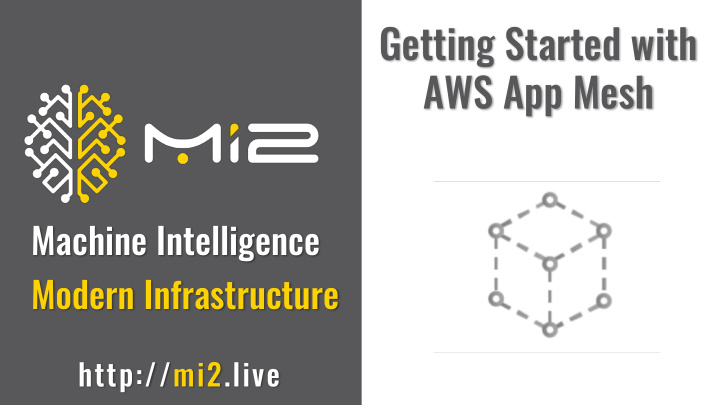



Getting Started with AWS App Mesh Machine Intelligence Modern Infrastructure http://mi2.live
What is MI2? MI2 Webinars focus on the convergence of machine intelligence and modern infrastructure . Every alternate week, I deliver informative and insightful sessions covering cutting-edge technologies. Each webinar is complemented by a tutorial, code snippets, and a video. MI2 strives to be an independent and neutral platform for exploring emerging technologies. Register at http://mi2.live
Objectives • Overview of Microservices • Challenges involved with Microservices • Why use a Service Mesh? • Big Picture of AWS App Mesh • Demo • Summary
Traditional 3 Tier Architecture UI Business Logic Data
Traditional 3 Tier Architecture UI C1 C1 C1 C1 C2 C2 C2 C2 C3 C3 C3 C3 AS 4 AS 1 AS 2 AS 3 Data
Microservices Architecture UI Node 1 Node 2 Node 3 Node 4 Node 5 C1 C2 C1 C2 C1 C2 C1 C2 C1 C2 C1 C3 C3 C3 C3 C3 C3 C3 C1 C3 Cluster Manager Data
Microservices Architecture S1 S2 S3
Challenges involved with Microservices Service B Service D Service A External Service C Service
Challenges involved with Microservices Java Ruby Service B Service D Python Service A C# External Service C Service
Challenges involved with Microservices Java Ruby Service B Service D Python Agent Agent Service A Agent C# External Service C Service Agent
Challenges involved with Microservices Java Ruby gRPC Service B Service D Python P Agent Agent T T H Service A Agent C# HTTP/2 External GraphQL Service C Service Agent
Challenges involved with Microservices Java Ruby gRPC Service B Service D L7 Python Agent Agent P T T H Service A L4 Agent C# HTTP/2 External GraphQL Service C Service Agent
Challenges involved with Microservices Central Monitoring Service Java Ruby gRPC Service B Service D L7 Python Agent Agent P T T H Service A L4 Agent C# HTTP/2 External GraphQL Service C Service Agent
Challenges involved with Microservices • Polyglot programming model • Language-specific tools and SDKs • Diverse set of protocols • Multiple deployment targets • Combination of load balancers • Complex debugging • Lack of visibility and observability • Hard to implement the best practices of distributed computing • Decentralized authentication and authorization
Service Mesh - A Possible Solution • Out of process architecture • Clean separation of data plane and control plane • Support internal and external load balancing (L3/L4/L7) • Consistent Service discovery • Extensible protocol support • Advanced health checks • Real-time monitoring, logging, tracing • Best practices of distributed computing
Service Mesh – Control Plane vs Data Plane Control Plane Java Ruby gRPC Service B Service D L7 Python P T T H Proxy Proxy Service A L4 C# Proxy HTTP/2 External GraphQL Service C Service Proxy
What is AWS App Mesh? • Managed service to monitor microservices running in AWS • Data plane is a combination of Envoy proxy and a router • Control plane is managed by AWS – exposed via CLI, API, Portal • Observability for microservices • Policy-driven communication and traffic routing • Scalable and available control plane • Tight integration with AWS services
AWS App Mesh – Control Plane vs. Data Plane AWS App Mesh – Control Plane Java Ruby gRPC Service B Service D L7 Python P T T H Proxy Proxy Service A L4 C# Proxy HTTP/2 External GraphQL Service C Service Proxy
Key Concepts of AWS App Mesh Service Mesh Logical boundary for network traffic between the services that reside within it Virtual Node Logical pointer to a particular task group, such as an ECS service or a Kubernetes deployment Virtual Router Handles traffic for one or more service names within your mesh Virtual Route Associated with a virtual router to direct traffic to one or more virtual nodes
Virtual Node Virtual Node Service Backends Listeners Discovery
Virtual Router Virtual Router Protocol Prefix Targets Virtual Node 1 Virtual Node 2
Virtual Route Protocol Prefix Targets Virtual Node 1 Virtual Node 2
AWS App Mesh – The Big Picture
AWS App Mesh Microservice 1 Observability Proxy Maps & Policy Definition Network Management Proxy Service Discovery Microservice 2 AWS App Mesh Control Plane
What are we building? • Three microservices connected via AWS App Mesh • Order • Product • Customer • Each service is a Kubernetes deployment • Order is exposed via ELB • Canary releases of Product and Customer services • Divert 50% of the traffic to Product v2 • Divert 25% of the traffic to Customer v1.5 • Maintain zero downtime!
Demo Scenario Product V1 Load Balancer Order Product V2 Customer V1.5 Customer V1.5
DEMO Performing Canary Releases with App Mesh https://github.com/janakiramm/app-mesh-tutorial
Summary • App Mesh is AWS’ implementation of Service Mesh • Each microservice runs an Envoy proxy • App Mesh control plane governs the traffic policies • Policies can be updated via CLI, SDK, or Console • Observability is available through CloudWatch and 3 rd parties
MI2 Sponsors
Next Webinar Bu Buil ilding ing Conv nvolutio iona nal Neural Networks s wit ith NVID VIDIA IA DIGIT IGITS NVIDIA DIGITS is a wizard-style framework to build convolutional neural networks. Attend this session to learn how to setup and configure NVIDIA DIGITS for building deep neural networks based on popular frameworks such as Caffe and TensorFlow. In this webinar, I will walk you through everything from data preparation to hyperparameter tuning to model serving. Thursday, February 7th, 2019 9:00 AM PST / 10:30 PM IST Register at http://mi2.live
Recommend
More recommend